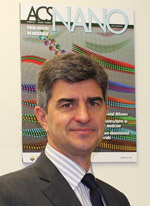题目: Ultrahigh Rate Energy Storage Using Two-dimensional Transition Metal Carbides (MXenes)
报告人:Prof. Yury Gogotsi
Department of Materials Science and Engineering,
and A. J. Drexel Nanomaterials Institute, Drexel University
题目: 2D Materials, Heterostructures and Devices: Opportunities and Challenges
报告人:Prof. Xiangfeng Duan 段镶锋
Department of Chemistry and Biochemistry, California Nanosystems Institute,
University of California, USA
时间:3月14日(周二) 14:00-16:00
地点:师昌绪楼403会议室
Ultrahigh Rate Energy Storage Using Two-dimensional Transition Metal Carbides (MXenes)
Yury Gogotsi
Department of Materials Science and Engineering, and A. J. Drexel Nanomaterials Institute, Drexel University, Philadelphia, PA 19104, USA http://nano.materials.drexel.edu
Two-dimensional (2D) solids offer unique properties and a potential path to device miniaturization. The most famous example is graphene, which is an atomically thin layer of carbon atoms bonded together in-plane with sp2 bonds. In 2011, a new family of 2D solids – transition metal carbides and nitrides (Ti2C, Ti3C2, Nb4C3, Ti4N3, etc.) – was discovered by Drexel University scientists [1]. These 2D solids with a composition Mn+1Xn (M is a transition metal, X is C or N) were labeled “MXenes”. More than 20 different carbides, nitrides and carbonitrides have been reported to date [2-5]. Structure and properties of numerous MXenes have been predicted by the density functional theory, showing that MXenes can be metallic or semiconducting, depending on their composition and surface termination. Their elastic constants along the basal plane are expected to be higher than that of the binary carbides. Oxygen or OH terminated MXenes are hydrophilic, but electrically conductive. Hydrazine, urea and other polar organic molecules can intercalate MXenes leading to an increase of their c lattice parameter [3]. One of the many potential applications for 2D Ti3C2 is in electrical energy storage devices such as batteries, Li-ion capacitors and supercapacitors [3-5]. Metallic MXenes have a potential for use in electromagnetic interference (EMI) shielding, transparent conducting coatings and many other applications [5,6]. MXenes can operate at the rates exceeding those of conventional double-layer supercapacitors, but still provide higher volumetric and areal capacitance than carbons, conducting polymers or transition metal oxides. A macroporous Ti3C2Tx MXene film delivered 210 Fg-1 at scan rates of 10 Vs-1 and 100 Fg-1 at 40 Vs-1, surpassing the best carbon supercapacitors known. Moreover, we show that MXene hydrogels are able to deliver volumetric capacitance of ~1500 Fcm-3.
1. M. Naguib, et al, Advanced Materials, 23 (37), 4207-4331 (2011)
2. B. Anasori, et al, ACS Nano, 9 (10) 9507–9516 (2015)
3. O. Mashtalir, et al, Nature Communication, 4, 1716 (2013)
4. M M. Ghidiu, Nature, 516, 78–81 (2014)
5. B. Anasori, M. R. Lukatskaya, Y. Gogotsi, Nature Reviews Materials, 2, 16098 (2017)
6. F. Shahzad, et al, Science 353, 1137-1140 (2016)
 Yury Gogotsi is Distinguished University Professor and Trustee Chair of Materials Science and Engineering at Drexel University. He is the founding Director of the A.J. Drexel Nanomaterials Institute and Associate Editor of ACS Nano. He works on nanostructured carbons and two-dimensional carbides for energy related and biomedical applications. His work on selective extraction synthesis of carbon and carbide nanomaterials with tunable structure and porosity had a strong impact on the field of capacitive energy storage. He has co-authored 2 books, more than 450 journal papers and obtained more than 50 patents. He has received numerous national and international awards for his research. He was recognized as Highly Cited Researcher by Thomson-Reuters in 2014-2016, and elected a Fellow of AAAS, MRS, ECS, RSC, ACerS and the World Academy of Ceramics.
Yury Gogotsi is Distinguished University Professor and Trustee Chair of Materials Science and Engineering at Drexel University. He is the founding Director of the A.J. Drexel Nanomaterials Institute and Associate Editor of ACS Nano. He works on nanostructured carbons and two-dimensional carbides for energy related and biomedical applications. His work on selective extraction synthesis of carbon and carbide nanomaterials with tunable structure and porosity had a strong impact on the field of capacitive energy storage. He has co-authored 2 books, more than 450 journal papers and obtained more than 50 patents. He has received numerous national and international awards for his research. He was recognized as Highly Cited Researcher by Thomson-Reuters in 2014-2016, and elected a Fellow of AAAS, MRS, ECS, RSC, ACerS and the World Academy of Ceramics.
2D Materials, Heterostructures and Devices: Opportunities and Challenges
Xiangfeng Duan(段镶锋)
Department of Chemistry and Biochemistry, California Nanosystems Institute, University of California, Los Angeles, CA 90095, USA
Abstract: Two-dimensional layered materials (2DLMs), such as graphene or molybdenum disulfide, represent an ideal 2D material system for exploring fundamental chemistry and physics at the limit of single atomic thickness. The covalently bonded atomic layers in 2DLMs are bound weakly to each other through van der Waals interactions, which offers considerable flexibility to isolate, mix and match individual atomic layers without the constraints of lattice and processing compatibility. It can therefore open up vast possibilities for nearly arbitrarily combining multiple materials and integrating distinct properties at the atomic scale, and thus enabling entirely new opportunities beyond the reach of existing materials. Here I will focus my discussion on exploring these 2D materials and their heterostructures as new platforms for the creation of a wide of electronic and optoelectronic devices with unique functions or unprecedented performance. Examples discussed include: high-speed transistors; a new design of vertical transistors for ultra-flexible electronics; and a series of of tunable photonic devices.
 Bio: Dr. Duan received his B.S. Degree from University of Science and Technology of China in 1997, and Ph.D. degree from Harvard University in 2002. He was a Founding Scientist and then Manager of Advanced Technology at Nanosys Inc., a nanotechnology startup founded based partly on his doctoral research. Dr. Duan joined UCLA with a Howard Reiss Career Development Chair in 2008, and was promoted to Associate Professor in 2012 and Full Professor in 2013. Dr. Duan’s research interest includes nanoscale materials, devices and their applications in future electronics, energy technologies and biomedical science. A strong emphasis is placed on the hetero-integration of multi-composition, multi-structure and multi-function at the nanoscale, and by doing so, creating a new generation of integrated nanosystems with unprecedented performance or unique functions to break the boundaries of traditional technologies. Dr. Duan has published over 180 papers in leading scientific journals, and holds over 40 issued US patents. For his pioneer research in nanoscale science and technology, Dr. Duan has received many awards, including MIT Technology Review Top-100 Innovator Award, NIH Director’s New Innovator Award, NSF Career Award, Alpha Chi Sigma Glen T. Seaborg Award, Herbert Newby McCoy Research Award, US Presidential Early Career Award for Scientists and Engineers (PECASE), ONR Young Investigator Award, DOE Early Career Scientist Award, Human Frontier Science Program Young Investigator Award, Dupont Young Professor, Journal of Materials Chemistry Lectureship, International Union of Materials Research Society and Singapore Materials Research Society Young Researcher Award, the Beilby Medal and Prize, and Nano Korea Award.
Bio: Dr. Duan received his B.S. Degree from University of Science and Technology of China in 1997, and Ph.D. degree from Harvard University in 2002. He was a Founding Scientist and then Manager of Advanced Technology at Nanosys Inc., a nanotechnology startup founded based partly on his doctoral research. Dr. Duan joined UCLA with a Howard Reiss Career Development Chair in 2008, and was promoted to Associate Professor in 2012 and Full Professor in 2013. Dr. Duan’s research interest includes nanoscale materials, devices and their applications in future electronics, energy technologies and biomedical science. A strong emphasis is placed on the hetero-integration of multi-composition, multi-structure and multi-function at the nanoscale, and by doing so, creating a new generation of integrated nanosystems with unprecedented performance or unique functions to break the boundaries of traditional technologies. Dr. Duan has published over 180 papers in leading scientific journals, and holds over 40 issued US patents. For his pioneer research in nanoscale science and technology, Dr. Duan has received many awards, including MIT Technology Review Top-100 Innovator Award, NIH Director’s New Innovator Award, NSF Career Award, Alpha Chi Sigma Glen T. Seaborg Award, Herbert Newby McCoy Research Award, US Presidential Early Career Award for Scientists and Engineers (PECASE), ONR Young Investigator Award, DOE Early Career Scientist Award, Human Frontier Science Program Young Investigator Award, Dupont Young Professor, Journal of Materials Chemistry Lectureship, International Union of Materials Research Society and Singapore Materials Research Society Young Researcher Award, the Beilby Medal and Prize, and Nano Korea Award.